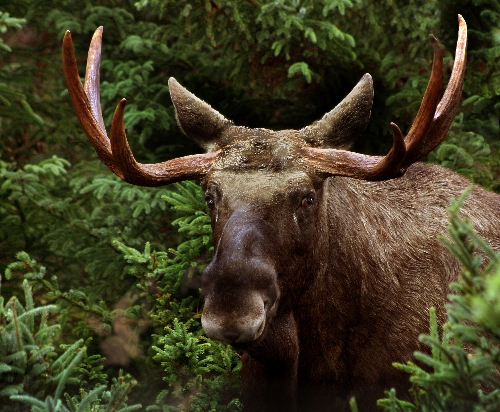General Moose Information
The moose is the largest member of the deer family and this translates into its diet. Moose require 9,770 calories per day just to sustain their body weight (“All About Moose” 3). To put that in perspective, 9,770 calories is the same as 17 footlong

turkey Subway sandwiches, and moose do not even eat meat (“Nutrition Information” 1). In one summer, a moose can consume 73 lbs of shrubs and woody plants, which explains why they are so dependent on access to vegetation for survival ("Moose World" 1). Due to the scarcity of food in the winter, moose must make up for nutritional deficiency in other seasons. In the summer, moose spend eight hours a day just chewing, which does not include the time spent foraging for vegetation (“Moose” 3).
Climate change will alter the vegetational landscape of the Adirondack Park in the next century and possibly even sooner. This change has the potential to be devastating to the moose which desperately needs access to specific vegetation. This will most likely force the moose to migrate northward potentially out of the Adirondack Park. This illustrates just how multifaceted conservation of moose in the park is. There are many factors that impact the stability of moose populations.
Finding adequate food supply is not the only difficulty Adirondack moose face another important factor in moose survival, also related to climate change, is temperature. They thrive in an extremely specific temperature range, which reflects their particular choices in natural habitat. Specifically, moose dislike anything above 50 degrees Fahrenheit, and will begin overheating around 60 degrees Fahrenheit. Thus, most moose habitats are located in the boreal forests of Canada and the Northern United States (“All About Moose” 5). Therefore, any impact to these areas’ temperatures puts great stress on the moose, as they cannot easily survive in other regions. The average temperature in New York is predicted to raise as much as 10 degrees Fahrenheit in the next century due to climate change, which has the potential to devastate the Adirondack moose. If they are not living under stressful conditions, moose have the potential to live upwards of 20 years (“All About the Moose” 3). This is another example of how climate change has the potential to put stress on the moose.
_______________________________________________________________________________________________________
 Moose may be sensitive to change and dependent on specific regions, but they have incredible physical abilities which increase likelihood of survival. Despite their size and bulky shape, moose are excellent swimmers. They can remain underwater for 30 seconds, and swim up to 6 mph for 10 miles ("All About Moose"). In addition to their aquatic prowess, moose are phenomenal runners on land, hitting speeds of 35 mph. They can maintain these speeds for 400 meters, and distances of 15 miles continuously (“All about Moose 5”). To put that in context, Usain Bolt’s world record in the 100 meter is 9.58 seconds, which puts him at an average speed of 23.5 mph, which is still significantly less than the moose’s capacity (Polachek 1). These fascinating qualities have clearly won over the hearts of people invested in the Adirondack region. It is impossible to enter a gift shop in the Adirondacks without seeing moose stickers, t-shirts and cups. There is a clear economic gain from the image of the moose. Conserving the moose is about more than preserving an ecosystem balance it is also about preserving an identity of the Adirondack Park and its tourist centric economy.
Moose may be sensitive to change and dependent on specific regions, but they have incredible physical abilities which increase likelihood of survival. Despite their size and bulky shape, moose are excellent swimmers. They can remain underwater for 30 seconds, and swim up to 6 mph for 10 miles ("All About Moose"). In addition to their aquatic prowess, moose are phenomenal runners on land, hitting speeds of 35 mph. They can maintain these speeds for 400 meters, and distances of 15 miles continuously (“All about Moose 5”). To put that in context, Usain Bolt’s world record in the 100 meter is 9.58 seconds, which puts him at an average speed of 23.5 mph, which is still significantly less than the moose’s capacity (Polachek 1). These fascinating qualities have clearly won over the hearts of people invested in the Adirondack region. It is impossible to enter a gift shop in the Adirondacks without seeing moose stickers, t-shirts and cups. There is a clear economic gain from the image of the moose. Conserving the moose is about more than preserving an ecosystem balance it is also about preserving an identity of the Adirondack Park and its tourist centric economy.
_______________________________________________________________________________________________________

Sources Cited
"All About Moose." National Parks Service, n.d. Web. 06 Apr. 2015.
Bell, Ronald L. "Moose". Wikipedia Commons, 29 June 2006. Web. 12 May 2015.
Brown, Doug. Moose Crossing Creek. Bicentennial Park. Flickr, 28 June 2013. Web. 12 May 2015.
"Moose (Alces Alces)." New Hampshire Fish and Game, n.d. Web. 06 Apr. 2015.
"Mooseworld: Moose Diet." n.d. Web. 25 Feb. 2015.
"Official SUBWAY Restaurants' Nutrition Information;." Official SUBWAY Restaurants' Nutrition Information;. Subway, n.d. Web. 10 May 2015.
Polachek, Emily. "6 Animals Faster Than Usain Bolt - Competitor.com." Competitorcom. Competitor Group, 12 Feb. 2014. Web. 12 May 2015.
Thyssen, Malene. "Male Elk." Wikipedia Commons. N.p., 19 Oct. 2006. Web. 12 May 2015.
Wirz, Dieter. "Moose Zoo Ostersund". Wikipedia Commons, 1 May 2006. Web. 12 May 2015.
